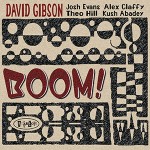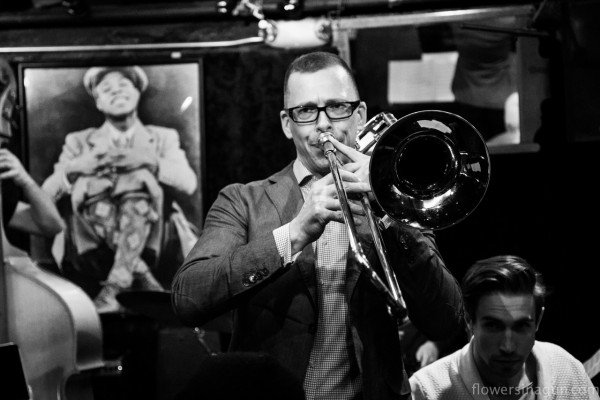
http://www.allaboutjazz.com/php/article.php?id=52903
It’s late morning on Sunday, January 17, 2016—a wintry New York day that will later see snow—and much of Brooklyn seems to be in a state of hibernation or hiding. There are few signs of life on the streets, but there’s no shortage of action in the basement of the former Public School 9 Annex. That’s where the studio known as Acoustic Recording is situated, and that’s where trombonist David Gibson has come to record what will be his fourth date for the Posi-Tone imprint and his seventh leader effort in total. As the session nears its start, Gibson is taking care of business: He’s warming up, looking over some parts, and chatting amiably with his band mates to keep the mood light. In short, he’s doing what any good leader will do to pave the way for success in such a situation.
Over the course of the first several hours of recording, Gibson demonstrates again and again that leadership is a fluid concept with no absolutes. There’s knowing where to begin and how to get everybody into the zone, something that he addresses through Dr. Billy Taylor‘s churchy “I Wish I Knew How It Would Feel To Be Free”; there’s having the flexibility and willingness to make adjustments when things aren’t going according to plan, demonstrated with some on-the-fly structural tweaks to bassist Alex Claffy‘s “AJ”; there’s a willingness to simply let the music flow when everything feels just right, exhibited during a metrically-morphing Gibson number dubbed “The Axe Grinder”; and there’s an awareness and openness to the thoughts of the other stakeholders in the room. By the time the band breaks for lunch, five songs are in the can—the three aforementioned numbers, a beautifully arranged “Here Comes The Sun,” and an appealing take on trombonist Curtis Fuller‘s “The Court”—and all is right with the recording process.
The same qualities exhibited during the first half of that session seem to also come to the fore in Gibson’s other musical goings-on. Whether fronting his own band in live settings, serving as Musical Director for the George Gee Swing Orchestra, putting his skills to good use in pianist Orrin Evans‘ Captain Black Big Band, sharing his hard-earned knowledge on his blog and in higher education settings, or serving in a strictly supportive role, Gibson remains the consummate professional—knowledgeable, malleable, organized, friendly, and fixed on the task at hand. In short, the David Gibson of 2016 is a pillar in his musical community and a man who could be said to have the world on a string. But that didn’t just happen for him. It’s something he willed over the course of his development, a non-stop expedition with the occasional bump in the road and a consistently upward trajectory. He’s the embodiment of President Dwight D. Eisenhower’s quote that “accomplishment(s) will prove to be a journey, not a destination.”
In a musical sense, Gibson’s journey began during his elementary school years in Mound, Minnesota. That’s when he first connected with the trombone, and that’s where the initial seeds for his future successes were planted. Gibson showed great promise during his first two years playing the instrument there, but his enthusiasm waned after the family moved to Oklahoma. There, students didn’t start playing instruments until the 7th grade, so the budding David Gibson found himself surrounded by neophytes who were two years behind him in their instrumental studies. He was ready to throw in the towel by the conclusion of his middle school years, and had the high school jazz band director not sent him a lifeline, he may very well have done just that. As Gibson recalls, “we received a telephone call from the jazz ensemble director at the high school who had heard of me and wanted to recruit me to be a part of the jazz ensemble. He said to my mom, ‘look, just have him come to one rehearsal. If he doesn’t like it after one rehearsal, he doesn’t have to come anymore.'”
That one rehearsal proved to be a life-changing event for the young David Gibson. It opened his eyes to a different world, one that showed the high yield that comes with great expectations. Looking back on it, Gibson reflects on the influence of his teacher and the key lesson that he learned from that experience: “My director was a military man and he had a real military philosophy about this. He was very hardcore, no nonsense in his dealings. And he did something then that I later learned was so important: He set the bar very high, so everybody reached for it.” The experience of working under such a commanding and demanding leader helped Gibson and many of his classmates to develop into strong players with great range and a deep understanding of what it takes to precisely shape the sound of a jazz ensemble. At the same time, Gibson’s private studies were helping him to learn the basic ins-and-outs of soloing and, even more importantly, assisting him in developing questioning techniques that would serve to guide him in the years to come.
At the conclusion of his high school years, Gibson moved on to the University of Central Oklahoma. There, he found himself at the center of a jazz program that, not unlike his high school group, emphasized ensemble execution over individual growth and expression. This brought out some feelings of discontentment in Gibson, who readily admits that he probably turned a lot of people off with the attitude he was projecting at that time. He notes, “[In that environment], the showmanship aspect—the veneer—ended up being much more important than the DNA of whatever the story was. So I was looking for a new mentality.” That mentality had everything to do with a search for a certain sound and method of expression. “I remember getting frustrated going through that search,” Gibson recalls, “because there [was a divide] between the music I was listening to versus what was fed to me. They were telling me to play like Urbie Green, play like Frank Rosolino, play like Carl Fontana, maybe play like Jack Teagarden. But nobody was telling me to play like Curtis Fuller. They weren’t even telling me to play like J.J. Johnson.”
Ultimately, it would be the influence of Fuller and Johnson—and the great Slide Hampton—that would provide the greatest direction for Gibson while also setting him apart from his peers during his undergraduate years. And it was encouragement from iconic trumpeter Clark Terry that would help Gibson to realize he was really onto something there. While attending and working at Terry’s summer jazz camps, the trumpet giant praised Gibson in his pursuit of that Fuller-Johnson-Hampton inspired direction. He also taught Gibson the value and importance of using whatever is at your disposal to “propel the story forward,” filling the role of mentor at an important stage in the trombonist’s musical and personal development.
To a large extent, Gibson’s college experience was about establishing a direction in performance and developing a personalized sound. But it was also about finding a voice through composition. Gibson’s interest in writing predated his arrival at the University of Central Oklahoma, as he dabbled in that department during his formative years. Unfortunately, he lacked real training or any sort of road map to follow when he was in high school. That all changed when he set foot on campus. As Gibson was just starting, Vince Norman, who would later go on to become the staff arranger for the U.S. Army’s Jazz Ambassadors, was on his way out. The two only overlapped for a single semester, but Norman helped steer Gibson in the right direction by sharing some of his knowledge and pushing him toward, and through, some of the information in Rayburn Wright’s Inside The Score.
There was no formal course of study for jazz composition that Gibson could’ve taken there at that time, but the knowledge gleaned from that book and the guidance and encouragement from Norman helped him to grow by leaps and bounds as a writer. At the same time that he was developing those writing skills, he was also able to use the big band at the school as his laboratory for experimentation. There, he quickly learned what worked and what didn’t in the charts he wrote. In discussion, he jokingly recalls learning about the true meaning of “fish paper”—a chart that’s so bad that it might as well just be used to “clean your fish on it”—during that period of time. But every one of those writing experiences for Gibson—good or bad—helped him to sharpen his pen and set him up for the next stage in his development.
The arrival at that next stage was bridged by a trip to Rochester, NY, where the International Trombone Association was holding its annual convention. That’s where Gibson would go on to win the Frank Rosolino Scholarship, meet Curtis Fuller for the first time, and learn of an opening in the Eastman School of Music’s composition program. All the stars aligned there, so Gibson moved to Rochester to study at Eastman upon completing his undergraduate degree. The years in Rochester—the mid to late ’90s—would prove to be a major transitional period in Gibson’s life. Marriage, personal growth, the birth of a daughter, immersion into a lively musical scene, completion of graduate work, a brief move back to Oklahoma followed by a divorce, and several more years making music in Rochester all came in and out of the picture over the course of (about) five years.
As the millennium was nearing its end, Gibson sensed a need for change. His girlfriend at the time was planning on moving to New York City, and he knew that that’s where he wanted and needed to be, so he up and moved there at the dawn of 1999. At that point, he was put to the test in a real pressure-cooker atmosphere, an environment that has sent many a musician packing. But Gibson wouldn’t be swayed or deterred by any experiences. Instead, he let any difficulties spur him on. There were a-ha moments to be had in many encounters, and Gibson was open to having them. One valuable lesson came from a respected trombonist who simultaneously gave Gibson some encouragement and advice. “I remember sitting in with Steve Davis at the old Savoy that was at 41st Street on the corner of Ninth Avenue,” Gibson recalls. “I sat in on a tune at the end of the night, and Steve complimented me on my playing. But then, in a subtle way, he also taught me an important lesson.” That lesson centered on the need to think about the music as much as you think about your own instrument. And it’s a lesson that Gibson took to heart, ultimately changing the way he heard the music and himself.
While Gibson looks back at his early years in New York City as lean years, his name was already starting to circulate during that period. He appeared as part of a trombone choir on Wycliffe Gordon‘s The Search (Nagel Heyer, 2000), worked with vocalist Nancy Wilson on her Christmas album, gigged and recorded with The Dizzy Gillespie Alumni All-Star Big Band, and began to cultivate his own scene, which would lead to his debut album—Maya (Nagel Heyer, 2002). Gibson notes the circumstances that led to that first leader session: “When I moved to town there was a little restaurant called Salt on Columbus Avenue and, maybe, 75th Street. They had music there four nights a week, and every night was a steady band. It was one of my regular hangs, and I knew I could usually sit in on the last set. I was introduced to a lot of people there. [pianist] Rick Germanson used to play there; that’s also where I became friendly with [saxophonist] Wayne Escoffery; and [saxophonist] Ian Hendrickson-Smith also had a steady night there.” The scene surrounding that restaurant and the connection that many of those musicians had to the Nagel Heyer imprint would eventually lead Gibson to their doorstep with part of an album. “When I got here, the first thing I realized is that I had no gigs,” Gibson amusingly notes. “But I wanted to keep writing music, so I started writing and got a group of people together to make what I thought was a demo. We went down to a studio on a Saturday afternoon and recorded about six tunes.” Gibson sent those recordings off to Nagel Heyer, the label liked what it heard, and the scene was set for Maya, a well-crafted album named after Gibson’s daughter.
Around the same time that Gibson sent that demo to Nagel Heyer to set the wheels in motion for Maya, he sent a copy of those same recordings to Slide Hampton. “When I came to New York,” Gibson remembers, “I immediately reached out to him to try to set up a lesson. I couldn’t arrange a lesson, but when I did the demo, I sent him a copy of it.” Upon hearing the music, Hampton called Gibson, praised his work, and invited him to take part in the reconstituted World Of Trombones band. It was a life-changing experience, giving Gibson the opportunity to work with some of his influences, travel to Europe to perform, and, a few years later, record with a slightly different version of the band on Hampton’s Spirit Of The Horn (MCG Jazz, 2003). It was also the scene for the development of a longstanding friendship between Gibson and Fuller, cemented during a potentially harrowing experience obtaining last-minute passport renewals and cultivated over the course of the many years that have followed.
Gibson’s career wasn’t in full bloom by 2003, but it was certainly moving toward that direction. He had a fairly steady flow of local gigs, his first album had entered the marketplace and received some positive press, he was about to begin a decade-plus stint teaching at the State University of New York at Geneseo, and his work with high profile figures like Hampton had helped to raise his profile in the jazz community at large. He was soon to receive another reputation boost through his participation and placing in the Thelonious Monk International Jazz Trombone Competition that year. It was an experience that almost never happened for Gibson, as the organization behind the competition had placed an age cap on the event. But the cap was eventually lifted, and Gibson went on to take Second Place honors in a strong field that included future heavyweights like Marshall Gilkes and First Place winner Andre Hayward. Gibson looks back on the whole experience with mixed feelings, but, nevertheless, the results helped to confirm his ascendancy into the upper ranks of jazz trombonists. His subsequent recordings would come to do the same.
The Path To Delphi (Nagel Heyer, 2005)—Gibson’s sophomore effort—was born out of a scene at another restaurant/gigging situation. Gibson explains, “I used to book these little gigs at a restaurant in my old neighborhood called Jesse’s Place. I had two nights a week that I would book there, and I would always have a lot of those tunes out that ended up on that record. Wayne would do some of those gigs, and [bassist] Dwayne Burno would do a lot of those gigs. So all the cats on that record would come through a lot and we would play a lot. It wasn’t in that configuration [on the record], but it was that cast of characters.” In addition, the record featured trumpet legend Randy Brecker, a somewhat last minute addition taking the place of an unavailable Dr. Eddie Henderson. Brecker, not surprisingly, fit in perfectly and rounded out the sextet. Gibson’s third record—G-Rays (Nagel Heyer, 2008)—languished on the shelf for several years before receiving an under-the-radar release, so all signs pointed to the need to make a change at that stage of the game. That’s when Posi-Tone Records came into sight.
Gibson’s first two records for that label—A Little Somethin’ (Posi-Tone, 2009) and End Of The Tunnel (Posi-Tone, 2011)—would come to feature a funky organ quartet that was born of a happy accident. “Around 2006,” Gibson recalls, “I received a call from [saxophonist/bassist] Mike Karn to play a gig at Fat Cat on a Saturday night. The band was me, [organist] Jared Gold, [drummer] Quincy Davis, and Karn. Then, I got a call in the middle of the day from [saxophonist] Julius Tolentino, telling me that Karn got food poisoning and couldn’t make the gig. So Julius says he’s going to cover him, but he tells me I should bring some music because he’s coming straight from another gig and he won’t have any. So, all of a sudden, I’m the leader.” In another strange twist, Tolentino ended up being unable to make the gig, leaving trumpeter Duane Eubanks to fill the void temporarily. But all of those eleventh hour changes did nothing to dampen the spirit of the performance that evening. That particular event marked the birth of a band, which included Tolentino, who eventually took over for an all-too-busy Eubanks, and led to a steady series of gigs and the aforementioned albums.
A bit further down the road, there was Boom! (Posi-Tone, 2015). It’s an album that’s at once bracing, beautiful, in the tradition, and outside the box. After two recordings and steady gigging with the organ quartet, Gibson switched gears. He enlisted a crew of young(er) guns—pianist Theo Hill, trumpeter Josh Evans, bassist Alex Claffy, and drummer Kush Abadey —and changed his outlook a bit, adopting an edgier quality while retaining the streamlined flow present in his earlier work. It proved to be a raving success, and Boom! became something of a breakout album for a man who already had five other records under his belt and fifteen years of high-level playing experience in New York. And that was just the beginning for Gibson in 2015. He also saw the release of Swing Makes You Happy! from the George Gee Swing Orchestra, a critically-hailed album featuring Gibson’s trombone work and his writing for a fierce little big band, and he took on a larger role with Orrin Evans’ Captain Black Big Band. It was a banner year for Gibson, and 2016 looks to be another one.
Two weeks after the session for Gibson’s forthcoming album we sit down for a lengthy talk at the Chelsea apartment he shares with his wife of five years—trumpeter Kiku Collins. Over the course of several hours he proves more than willing to look in on his past, evident in the personalized history that informs this writing, but he’s more eager to discuss the present. He’s rightfully enthused about the music he just recorded, featuring the same band on Boom! minus Josh Evans, who’s replaced by trumpeter Freddie Hendrix; he’s thrilled with the current state of affairs in the aforementioned large ensembles he works with; and he’s both happy with his life as it is and eager to keep moving forward, noting that the two aren’t mutually exclusive. He speaks with candor and humor, never tries to sugarcoat anything, and finds a good deal of wisdom and clarity in both the lemons and the laurels that life can hurl at you. Through conversation and action he shows himself to be a pragmatist in practice, a philosopher at heart, a realist in his exploration of self, and an optimist for the modern age. The David Gibson of today only exists because of the fact that the David Gibsons of the past were open enough to let life’s truths reveal themselves and hold sway over future outcomes. And as Clark Terry once taught him to do, he’s propelling the story forward.
By Dan Bilawsky
 The young trumpeter Josh Lawrence is making quite a splash on the contemporary scene as a player and composer. “Contrast” is his second Posi-Tone album within 12 months to feature his Color Theory ensemble. What a fine band! The rhythm section includes the Curtis Brothers, Zaccai (keyboards) and Luques (bass) plus Anwar Marshall (drums) while the front line has Lawrence paired with alto saxophonist Caleb Curtis (no relation to the Brothers). Orrin Evans joins the band on piano for several tracks as does trombonist David Gibson.
The young trumpeter Josh Lawrence is making quite a splash on the contemporary scene as a player and composer. “Contrast” is his second Posi-Tone album within 12 months to feature his Color Theory ensemble. What a fine band! The rhythm section includes the Curtis Brothers, Zaccai (keyboards) and Luques (bass) plus Anwar Marshall (drums) while the front line has Lawrence paired with alto saxophonist Caleb Curtis (no relation to the Brothers). Orrin Evans joins the band on piano for several tracks as does trombonist David Gibson.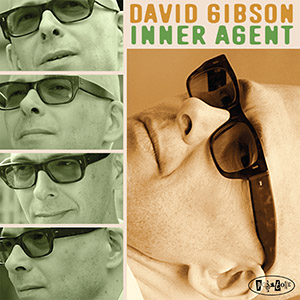
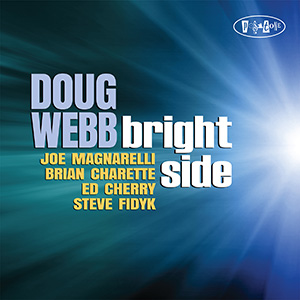 Doug Webb’s most emotional call to look on the Bright Side is a most appropriate offering in these ‘times of trouble’. In this respect, Julie Styne’s feature, ‘Guess I’ll Hang My Tears Out To Dry’ becomes the disc’s clarion call to listeners in search of peace. But let it be suggested that the saxophonist’s disc in question is an endless stream of moping about current events and an apocalyptic sermon about the state of the art, it has to be said that Webb is not one to weep and moan about it. Rather he is more apt to press on and serve up such delicacies as ‘Steak Sauce’ and ‘Funky Medina’. Making an ebullient record takes not only a sense of fun, but elegant simplicity, given to joyous celebration of all things musical. It also shows Webb to possess a more theatrically developed virtuosity necessary for a performance that highlights his compelling works. More rewarding on the ensemble front, both structurally and emotionally is Webb’s prominent interaction with musical partners who articulate the loose-limbed elegance of the music with impressive timbral variety.
Doug Webb’s most emotional call to look on the Bright Side is a most appropriate offering in these ‘times of trouble’. In this respect, Julie Styne’s feature, ‘Guess I’ll Hang My Tears Out To Dry’ becomes the disc’s clarion call to listeners in search of peace. But let it be suggested that the saxophonist’s disc in question is an endless stream of moping about current events and an apocalyptic sermon about the state of the art, it has to be said that Webb is not one to weep and moan about it. Rather he is more apt to press on and serve up such delicacies as ‘Steak Sauce’ and ‘Funky Medina’. Making an ebullient record takes not only a sense of fun, but elegant simplicity, given to joyous celebration of all things musical. It also shows Webb to possess a more theatrically developed virtuosity necessary for a performance that highlights his compelling works. More rewarding on the ensemble front, both structurally and emotionally is Webb’s prominent interaction with musical partners who articulate the loose-limbed elegance of the music with impressive timbral variety.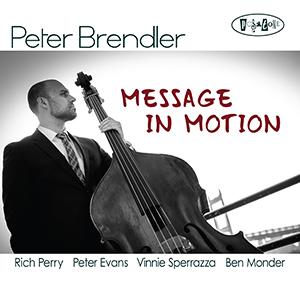 Apart from the fact that Duke Ellington did not get credit for ‘Angelica’ in bassist Peter Brendler’s Message In Motion everything else about the album suggests the impulse to adorn musical lines with an intricacy that goes well beyond craftsmanship. It is matter of imbuing musical design with depth of thought and emotion melded in with clarity and reason. Peter Brendler’s work has shown this in spades throughout his illustrious career as a first-call bassist as well as a composer. His work with pianist Frank Kimbrough and drummer Barry Altschul is the stuff that legends are made of. In only his second album as leader, Brendler not only commands the respect of musical luminaries such as saxophonist Rich Perry and guitar alchemist Ben Monder, but also trumpeter Peter Evans and drummer Vinnie Sperrazza. ‘Stunts And Twists’ helps to unveil Brendler’s compositional skills, suggesting a wonderful sense of adventure about his narratives. His introduction to Elliott Smith’s ‘Easy Way Out’ is quite breathtaking as is Ben Monder’s playing that follows immediately after, as it makes way for Brendler to re-enter with melodic lines of his own. Alice Coltrane’s ‘Ptah The El Daoud’ features an insane, dysfunctional and brilliant solo by Peter Evans, who unleashes his genius once again on ‘Very Light And Very Sweet. A truly memorable album.
Apart from the fact that Duke Ellington did not get credit for ‘Angelica’ in bassist Peter Brendler’s Message In Motion everything else about the album suggests the impulse to adorn musical lines with an intricacy that goes well beyond craftsmanship. It is matter of imbuing musical design with depth of thought and emotion melded in with clarity and reason. Peter Brendler’s work has shown this in spades throughout his illustrious career as a first-call bassist as well as a composer. His work with pianist Frank Kimbrough and drummer Barry Altschul is the stuff that legends are made of. In only his second album as leader, Brendler not only commands the respect of musical luminaries such as saxophonist Rich Perry and guitar alchemist Ben Monder, but also trumpeter Peter Evans and drummer Vinnie Sperrazza. ‘Stunts And Twists’ helps to unveil Brendler’s compositional skills, suggesting a wonderful sense of adventure about his narratives. His introduction to Elliott Smith’s ‘Easy Way Out’ is quite breathtaking as is Ben Monder’s playing that follows immediately after, as it makes way for Brendler to re-enter with melodic lines of his own. Alice Coltrane’s ‘Ptah The El Daoud’ features an insane, dysfunctional and brilliant solo by Peter Evans, who unleashes his genius once again on ‘Very Light And Very Sweet. A truly memorable album.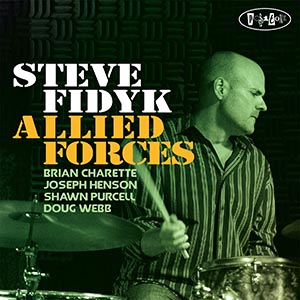 If it were time to draw up a list of the finest performances of 2016, then Steve Fidyk’s Allied Forces would feature very prominently on it. For one thing, this is not the usual organ/guitar/drum recording but an intelligent spinoff that features an infinitely larger and fascinating tonal colour palette with the addition of an alto and a tenor saxophone. The recording also shows the drummer/leader, Fidyk to not only possess formidable artistic gifts as a percussion colourist, but also a drummer of immense melodic capability. Fidyk’s musicianship also shows to be a bold instrumentalist and gifted writer. These complementary aspects paint a portrait of a musician with the facility to transform and illuminate in a myriad styles. It helps to have a sensibility rooted in, arguably, the last, and most significant idiom in Jazz – bebop. The group’s performance of Charlie Parker’s ingenious ‘Moose The Mooche’ and Thelonious Monk’s iconic ‘Evidence’ gets behind the irrepressible rhythmic dynamic of the music that Parker and Monk helped to create with Kenny Clarke and Dizzy Gillespie. But Fidyk is also a chameleonic musician. Consider the manner in which he whips up a funky storm on ‘Doin’ The Shake’. And the, of course, there’s the rousing rendition of Frank Foster’s ‘Shiny Stockings’ a marvellous bookend to ‘Evidence’, which gets things started. An album to die for.
If it were time to draw up a list of the finest performances of 2016, then Steve Fidyk’s Allied Forces would feature very prominently on it. For one thing, this is not the usual organ/guitar/drum recording but an intelligent spinoff that features an infinitely larger and fascinating tonal colour palette with the addition of an alto and a tenor saxophone. The recording also shows the drummer/leader, Fidyk to not only possess formidable artistic gifts as a percussion colourist, but also a drummer of immense melodic capability. Fidyk’s musicianship also shows to be a bold instrumentalist and gifted writer. These complementary aspects paint a portrait of a musician with the facility to transform and illuminate in a myriad styles. It helps to have a sensibility rooted in, arguably, the last, and most significant idiom in Jazz – bebop. The group’s performance of Charlie Parker’s ingenious ‘Moose The Mooche’ and Thelonious Monk’s iconic ‘Evidence’ gets behind the irrepressible rhythmic dynamic of the music that Parker and Monk helped to create with Kenny Clarke and Dizzy Gillespie. But Fidyk is also a chameleonic musician. Consider the manner in which he whips up a funky storm on ‘Doin’ The Shake’. And the, of course, there’s the rousing rendition of Frank Foster’s ‘Shiny Stockings’ a marvellous bookend to ‘Evidence’, which gets things started. An album to die for.
